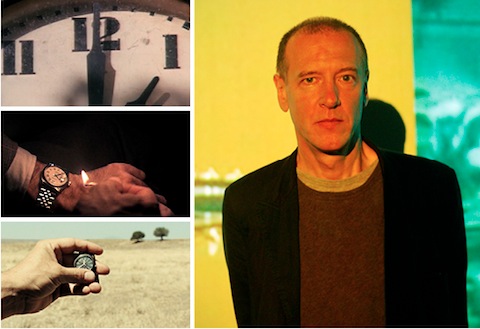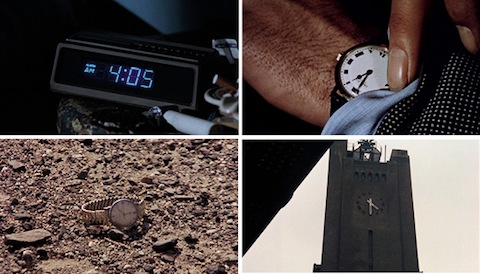
Christian Marclay’s The Clock: In Anticipation
On Thursday 29th March, Christian Marclay’s The Clock chimes a new era for Sydney’s Museum of Contemporary Art. Susie Burge counts down.

Christian Marclay’s magnum opus The Clock, a 24-hour video mash-up of film and tv clips referencing time that runs in real time, thus telling the time, makes good copy. It’s impossible, really, to properly illustrate with a selection of images (the work being made up of literally thousands of tiny segments from famous and not so famous scenes that are connected in clever, disparate literal and/or metaphoric ways, including creative sound editing), and hence words rather than visuals have come to the fore. Since The Clock’s debut at White Cube in London in 2010, writers have made inspired attempts to convey the essence of the thing. After seeing The Clock at Paula Cooper Gallery in NYC, British novelist Zadie Smith wrote a brilliant essay for the New York Review of Books titled “Killing Orson Welles at Midnight”. Her evocative prose makes one simply ache to experience the work itself.

Above: Stills from The Clock (see credits below) and portrait of Christian Marclay (image by Dr. J Caldwell)
Christian Marclay’s magnum opus The Clock, a 24-hour video mash-up of film and tv clips referencing time that runs in real time, thus telling the time, makes good copy. It’s impossible, really, to properly illustrate with a selection of images (the work being made up of literally thousands of tiny segments from famous and not so famous scenes that are connected in clever, disparate literal and/or metaphoric ways, including creative sound editing), and hence words rather than visuals have come to the fore. Since The Clock’s debut at White Cube in London in 2010, writers have made inspired attempts to convey the essence of the thing. After seeing The Clock at Paula Cooper Gallery in NYC, British novelist Zadie Smith wrote a brilliant essay for the New York Review of Books titled “Killing Orson Welles at Midnight”. Her evocative prose makes one simply ache to experience the work itself.
“It’s two in the afternoon” she opens. “No one is groaning; no one turns over in bed or hits an alarm clock – it’s much too late for that. Love set you going like a fat gold watch … But by two o’clock the morning song is just a memory. We are no longer speculating as to what set us going, we just know we are going. We are less sentimental in the afternoon.” Smith goes on finish that wonderful first paragraph with “and Charlotte Rampling is all by herself eating chocolate éclairs and smoking, in a garden somewhere, in France, probably.”
Zadie Smith creates atmosphere, but she’s incisive and philosophical too. “When Orson Welles says what time it is, it lends the hour an epic sound. At two AM everyone’s lonely.”
By all accounts, Smith’s included, there’s loads of humour in The Clock. Pathos and bathos. Recognisable images and obscure ones. Mary Poppins, James Bond, Bette Davis, Colombo, The Avengers, Paul Newman, Peter Fonda, Juliette Binoche, Jeff Bridges. Harold Lloyd clings to the hands of a clock on the top of a skyscraper at 2.45pm. There’s Gary Cooper in High Noon. Fake clocks and real time; staged time and actual time; collapsing of narrative time and the long drawn out process of sixty minutes in each and every hour of the day. In April last year, The Guardian called The Clock “A masterpiece of our times,” suggesting that by the time we read this it may be possible to order the work as a streaming video-app timepiece to download to iPhone. The Clock (alas??) remains Art – it’s been acquired jointly by London’s Tate, the Centre Pompidou in Paris and The Israel Museum in Jerusalem.
Marclay won the Golden Lion for Best Artist with The Clock at last year’s 54th Venice Biennale. It’s attracted record crowds wherever it’s been shown. It was a highlight of London’s Frieze. Boston Globe critics took shifts to cover it in entirety. It’s travelled to Japan, LA, Moscow. New York Magazine put The Clock number one in its top ten list of art events for 2011, ahead of the De Kooning retrospective at MoMA and Alexander MacQueen at the Met. The Clock appears to seduce intelligentsia and the general public alike, not to mention art lovers and film buffs.

Above: Stills from The Clock (see credits below)
In a recent (March 12) issue of the New Yorker there’s a leisurely, long form profile by Daniel Zalewski that’s worth seeking out. The essay is thoughtful and well written, terrific for background on Marclay, and for explicating the complex process of making the work – it took the artist three years of editing after a team of researchers unearthed the material, and that was just visuals, sound proved even more tricky. There’s a lighter (but no less intelligent) blog by the same author “Night Shift with The Clock”, comparing Marclay’s montage with “the uncanny moments in Haruki Murakami’s novels when characters cross over into a parallel universe”.
Sydneysiders, it’s time to prepare. Melbournians, Brisvegans, Taswegians, those from the West – plans need to be made. Diary dates will be required. The Clock runs for nine and a half weeks at the MCA, but there are just ten 24-hour showings (each Thursday for the duration of the exhibition). Rare windows to catch the tolling of midnight, the witching hour, a thief. To view the dark side, those dreamlike, insomniac moments (in art, in life) when the world exhales and whisky seems a terrible good idea. Will there be a rush on? Will we, as Zadie Smith suggests “realize that The Clock is neither bad or good, but sublime, maybe the greatest film you have ever seen, and you will need to come back in the morning, in the evening, and late at night, abandoning everything else, packing a sleeping bag, and decamping to the Paula Cooper Gallery until sunrise. Except: Christ, is that the time?”
Christian Marclay’s The Clock is showing at the new MCA, reopening after a 53 million dollar makeover. Dates: 29th March – 3rd June, 2012 - www.mca.com.au
Running concurrently at the MCA is an international group exhibition Marking Time curated by Rachel Kent and including talented young Scottish artist Katie Paterson and the incomparable Gulumbu Yunupingu among others.
Read Zadie Smith’s full essay here - www.nybooks.com/articles/
New Yorker article www.newyorker.com
See the 3 minute You Tube clip at 12.04 precisely - www.youtube.com/watch?v=xp4EUryS6ac
- Susie Burge, all rights reserved
- Images Christian Marclay Portrait: Dr. J Caldwell, other images stills from The Clock 2010: Christian Marclay, The Clock 2010, Single channel video, Duration: 24 hours, © the artist. Courtesy White Cube, London and Paula Cooper Gallery, New York